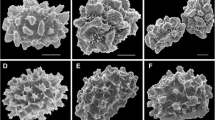Abstract
Apatesia N.E.Br. GC 1927: 12; Ihlenfeldt & Gerbaulet 1990: 457–498; Hartmann 2001: 65–66 Lectotypus A. pillansii N.E.Br. Etym Gk apatesis, deception, because the plants are so similar to Hymenogyne in vegetative state that they can be confused.
Access provided by CONRICYT-eBooks. Download reference work entry PDF
Similar content being viewed by others
Apatesia N.E.Br. GC 1927: 12; Ihlenfeldt & Gerbaulet 1990: 457–498; Hartmann 2001: 65–66 Lectotypus A. pillansii N.E.Br. Etym Gk apatesis, deception, because the plants are so similar to Hymenogyne in vegetative state that they can be confused.
Annuals; L flat, oval, those of a pair forming an open basal sheath, only slightly succulent, with prominent bladder cells along the margins, epidermis with wax platelets; Fl in rich cymes representing the entire plant, petals yellow, ciliate in their lower half, filamentous staminodes papillate, filaments with dense, inflated papillae towards their tips, nectary as a ring, hardly lophomorphic, stigmas basally pasted together, not connate; Fr base ± flat, top the same height or higher, short expanding keels radial on valves, valve wings absent or narrow, locules open or partially covered by overarching septa, some seeds enclosed in basal seed pockets derived from false septa, dispersal at first ombrohydrochorous, septa and adnate seed pockets later dispersed by wind as tumble fruit units, 8–12 locules; S smooth to papillate, light to dark brown; Chr 2n = 18; Ecol in sandy places, winter rainfall > 200 mm p.a. (Fig. 1); Distr all western districts in WC, S Africa.
Note: In habit similar to Hymenogyne, but in fruit morphology resembling more closely Conicosia.
Key to the Species of Apatesia
1. | Top of capsule conical | A. helianthoides |
– | Top of capsule rounded | 2 |
2. | Septa overarching the locules only distally | A. pillansii |
– | Septa overarching the locules throughout their length | A. sabulosa |
A. helianthoides (Aiton) N.E.Br. GC 1927: 12 ≡ M. helianthoides Aiton 1789: 193 LT, designated by Ihlenfeldt & Gerbaulet 1990: 480, drawing of Anne Lee (BM) = M. helianthoides Aiton var. glabrum Sonder in Harvey & Sonder 1862: 459 ≡ M. helianthoides Aiton var. glaucum Sonder ex H.Jacobsen 1981: 617 orthographical variant T Zeyher 707 (BM?).
L ovate, narrowing into a broad petiole; Fl ∅ c. 40 mm (Fig. 2); Fr 5-angular with a conical top with centrally raised septa underneath, locules completely open, valve wings absent; S light brown, smooth; Ecol 200–400 mm rainfall p.a. in winter; Distr Clanwilliam, Piquetberg, Vanrhynsdorp, Vredendal, WC, S Africa.
Note: A. helianthoides inhabits the driest parts of the area of the genus.
-
A. maughanii = A. sabulosa
A. pillansii N.E.Br. JB 1928: 138 T Pillans s.n., Oct. 1926 (K)
L narrowly ovate, petiolate; Fl ∅ 20–30 mm; Fr usually circular as seen from above, septa overarching the locules only distally, valve wings absent; S light brown, somewhat papillate; Ecol >400 mm rainfall p.a. in winter; Distr S and coastal part of the area of the genus, WC, S Africa.
Note: The species occurs in the southern coastal parts of the area of the genus.
A. sabulosa (Thunberg) L.Bolus NM3 1950: 229 ≡ M. sabulosum Thunberg 1791: 17 T Thunberg 12012a (UPS!) = A. maughanii N.E.Br. GC 1932: 263 T Maughan Brown s.n. Nov. 1928 (K).
L narrowly ovate, petiolate; Fl ∅ 20–30 mm; Fr rarely 5-angular, top with a central tip formed by the raised valve tips, septa overarching the locules completely; S brown, papillate; Ecol c. 200–300 mm rainfall p.a. in winter; Distr Ceres, Clanwilliam, Vanrhynsdorp, WC, S Africa.
Note: The species grows further inland than A. pillansii and partly sympatrically with A. helianthoides.
References
Aiton W. (1789) Hortus Kewensis, ed. 1, 2: 177–196. Nicol, London
Bolus L. (1936–1958) Notes on Mesembryanthemum and allied genera. NM3: 1–19 (5.2.1936), 21–44 (31.7.1936), 45–78 (14.1.1937), 79–114 (12.8.1937), 115–138 (24.3.1938), 139–188 (20.7.1939), 189–236 (25.8.1950), 237–288 (30.8.1954), 289–417 (30.4.1958). University of Cape Town. Cape Town
Brown N.E. (1927) Mesembryanthemum … GC 81: 12, 31–33, 52–53, 70, 84–85, 113–114, 116, 251–253, 430; GC 82: 92–93, 113–114, 228, 251, 263, 290–291, 348–349, 369, 390, 409, 429–430, 449–450, 470–471, 489–490, 509–511
Brown N.E. (1928) Mesembryanthemum and allied genera. JB 66: 75–80, 106–107, 138–145, 171–172, 267–268, 322–327
Brown N.E. (1932) Mesembryanthemum. GC 91: 144, 205, 262–263
Hartmann H.E.K. (2001): Illustrated Handbook of Succulent Plants: Aizoaceae A-E. Springer. Heidelberg
Harvey W.H., Sonder W. (1862) Flora Capensis 2: 386–478, 596–598, 616. Hodges, Smith & Co, Dublin
Ihlenfeldt H.-D., Gerbaulet M. (1990) Untersuchungen zum Merkmalsbestand und zur Taxonomie der Gattungen Apatesia N.E.Br., Carpanthea N.E.Br., Conicosia N.E.Br., Herrea Schwantes und Hymenogyne Haw. (Mesembryanthemaceae Fenzl) BJS 11: 457–498
Jacobsen H. (1981) Das Sukkulentenlexikon, ed.2. Fischer, Jena
Sonder O.W. (1862) Aizoon. Galenia. Mesembryaceae. Trianthema. In: Harvey W.H., Sonder W. (eds) Flora Capensis
Thunberg P. (1791) Descriptiones Mesembryanthemorum quorundam in Capitis Bonae Spei Africes … Novorum Actorum medico-physicorum academiae Caesareae Leopoldino-Carolinae naturae curiosorum in Germania 8: App.: 1–18
Author information
Authors and Affiliations
Corresponding author
Editor information
Editors and Affiliations
Rights and permissions
Copyright information
© 2017 Springer-Verlag GmbH Germany
About this entry
Cite this entry
Hartmann, H.E.K. (2017). Apatesia Ruschioideae . In: Hartmann, H. (eds) Aizoaceae. Illustrated Handbook of Succulent Plants. Springer, Berlin, Heidelberg. https://doi.org/10.1007/978-3-662-49260-4_11
Download citation
DOI: https://doi.org/10.1007/978-3-662-49260-4_11
Published:
Publisher Name: Springer, Berlin, Heidelberg
Print ISBN: 978-3-662-49258-1
Online ISBN: 978-3-662-49260-4
eBook Packages: Biomedical and Life SciencesReference Module Biomedical and Life Sciences






